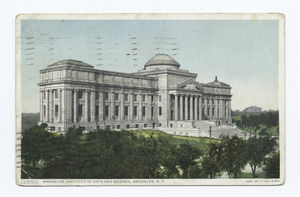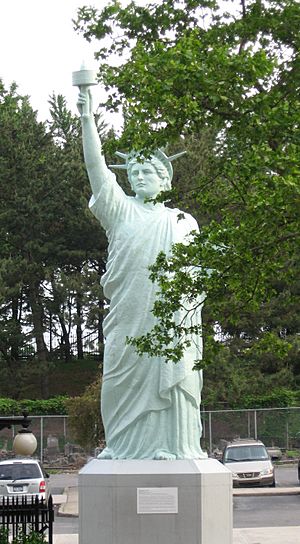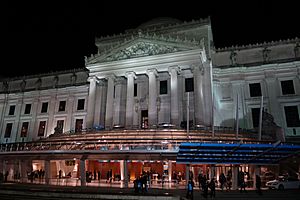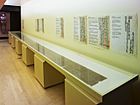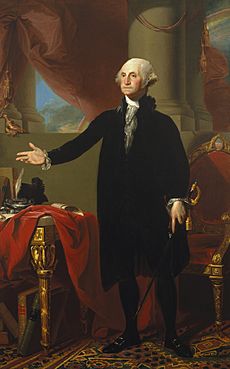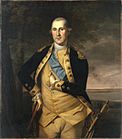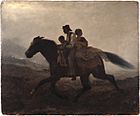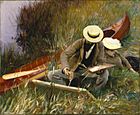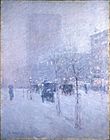Brooklyn Museum facts for kids
 |
|
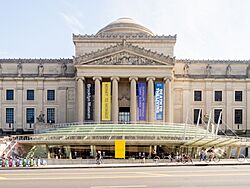
Entrance facade of Brooklyn Museum
|
|
| Former name | Brooklyn Institute of Arts and Sciences, Brooklyn Museum of Art |
|---|---|
| Established | August 1823 (as Brooklyn Apprentices' Library) |
| Location | 200 Eastern Parkway, Brooklyn, New York |
| Type | Art museum |
| Collection size | 500,000 objects |
| Public transit access | Subway: |
The Brooklyn Museum is a large art museum located in the New York City borough of Brooklyn. It is the city's second-largest art museum and holds a huge collection of about 500,000 objects from all over the world. The beautiful building was designed in the Beaux-Arts style by the famous architects McKim, Mead & White.
The museum started in 1823 as a library for young workers. It grew over time and moved into its current building in 1897. The museum's goal was to be a place for everyone to enjoy art. After some tough times, the museum was updated in the late 20th century and is now a popular spot for art lovers.
Some of the museum's most amazing collections include ancient art from Egypt, Europe, Africa, and Japan. The Egyptian collection is especially famous, with items that are over 3,000 years old. The museum also has a large collection of American art, from the colonial period to modern times. You can see works by famous artists like Mark Rothko, Edward Hopper, Georgia O'Keeffe, and Judy Chicago.
History of the Museum
How It All Started
The Brooklyn Museum began in 1823 when Augustus Graham founded the Brooklyn Apprentices' Library. It was a place for young people to learn. In 1843, it joined with the Brooklyn Institute, which showed paintings and sculptures.
In 1889, leaders in Brooklyn decided to build a grand new museum. They chose a spot near Prospect Park. The new organization was called the Brooklyn Institute of Arts and Sciences. They held a competition to choose the best design for the building, and the firm McKim, Mead & White won.
Construction on the first part of the museum began in 1895. The building was finished in 1897, and the museum officially opened on October 2. This was just before Brooklyn became part of the larger City of Greater New York in 1898.
Growing in the 20th Century
The museum continued to grow. A central section with a grand entrance was added, opening in 1907. This made the museum much larger, but it was still only a small part of the original giant plan. The museum struggled with money, but it kept adding new art and exhibits.
By the 1920s, a new subway station opened right outside the museum, making it much easier for people to visit. The museum added new galleries for Japanese art and art from different European countries. In 1929, it opened 19 American period rooms, which are rooms decorated to look like they did in a specific time in history.
In the 1930s, the museum's main entrance was changed. The grand staircase was removed, and a new ground-level entrance was built. This made the museum more modern and welcoming. New galleries for Persian and medieval art also opened.
During the 1950s and 1960s, the museum faced money problems again. But it continued to add new galleries, including a sculpture garden with pieces from old New York City buildings. It also started showing art by Black artists from New York in its new Community Gallery, which was a big step forward.
Changes and Challenges
In the 1970s, the museum continued to struggle with funding. At one point, it had to close two days a week because there weren't enough security guards. However, it also opened new galleries for Korean, Japanese, and African art.
In the 1980s, a new director, Robert Buck, worked hard to attract more visitors and raise money. The museum started offering more art classes and even ran TV ads. In 1986, a big plan was announced to make the museum much larger, but it was very expensive.
A major renovation began in the 1990s. A new auditorium opened in 1991, and in 1993, a large part of the west wing was reopened with beautiful new gallery spaces. For a while, the museum was called the Brooklyn Museum of Art to make its purpose clearer to visitors.
The Museum in the 21st Century
In 2004, the museum opened a stunning new glass entrance, making the front of the building look modern and inviting. At the same time, it changed its name back to the Brooklyn Museum. The museum also opened the Elizabeth A. Sackler Center for Feminist Art in 2007, which celebrates art by women.
The museum has continued to update its galleries. The African art gallery was moved and reopened in 2011, and the Chinese and Japanese art galleries were renovated and reopened in 2019.
In 2021, the museum received a $50 million gift from the New York City government. This money is being used to renovate more of the building and create new gallery spaces. In 2024, the museum opened a new education center with art studios for visitors.
The Museum Building
The Brooklyn Museum is a beautiful building designed in a style called Neoclassical, which was inspired by ancient Greek and Roman architecture. It is so important that it is a New York City designated landmark and is listed on the National Register of Historic Places.
The Outside of the Building
The original plan for the museum was huge, about four times bigger than what was actually built. Only the northern part of the building was completed. The main front of the museum faces Eastern Parkway and has a grand entrance with large columns.
Above the entrance, there are sculptures created by Daniel Chester French, the same artist who designed the statue of Abraham Lincoln at the Lincoln Memorial in Washington, D.C. Along the top of the building, there are 30 large statues of figures representing different cultures and ideas from history.
The modern entrance, built in 2004, is a large glass structure that creates a welcoming "front stoop" for Brooklyn.
Inside the Museum
The inside of the museum has changed a lot over the years. The main lobby was once an auditorium. Today, it is a large, open space with tall columns that serves as a central gallery.
The museum has many different galleries spread across its floors. Some galleries have been renovated to have clean, white walls and simple lighting to make the art stand out. The building also has a visible storage area, where you can see thousands of objects from the collection that are not on display in the main galleries.
Collections and Art
The Brooklyn Museum has art from almost every corner of the world. Its collections are known for their variety and high quality.
Egyptian and Ancient Art
The museum's collection of art from ancient Egypt is one of the best in the world. It includes statues, jewelry, and even papyrus scrolls with ancient writing. One of the most famous pieces is a small clay figure called the "Bird Lady." The collection shows what life was like in Egypt over 3,000 years ago.
American Art
The American art collection features paintings, sculptures, and prints from the 1700s to the mid-1900s. It includes famous works like Gilbert Stuart's portrait of George Washington and Winslow Homer's painting Eight Bells.
The collection shows the history of American art through the eyes of many different artists. You can see everything from portraits of early American leaders to beautiful landscapes and scenes of everyday life.
Highlights from the American Collection
-
Charles Willson Peale, George Washington, c. 1776
-
Edward Hicks, The Peaceable Kingdom, c. 1830–1840
-
Eastman Johnson, A Ride for Liberty – The Fugitive Slaves, c. 1862
-
Winslow Homer, The Northeaster, c. 1883
-
John Singer Sargent, Paul César Helleu Sketching with His Wife, 1889
-
George Bellows, A Morning Snow – Hudson River, 1910
-
Georgia O'Keeffe, Blue 1, 1916
Art from Around the World
The museum has amazing collections of art from Africa, Asia, and the Pacific Islands. The African art collection has over 6,000 objects, including beautiful sculptures, masks, and jewelry. The Asian art galleries feature thousands of years of art from China, Japan, Korea, and other countries.
The museum also has a wonderful collection of European paintings. You can see works by famous artists like Claude Monet, Edgar Degas, and Vincent van Gogh.
Elizabeth A. Sackler Center for Feminist Art
Opened in 2007, this center is a special part of the museum dedicated to feminist art. It celebrates the achievements of women artists. Its most famous piece is The Dinner Party by Judy Chicago. This amazing installation features a giant triangular table with 39 place settings, each honoring an important woman from history.
Visiting the Museum
The Brooklyn Museum is a lively place with many programs for visitors. On the first Saturday of every month, the museum hosts a popular event with free admission, music, dancing, and art activities for families.
The museum also has special programs for teens, who can become apprentices and give tours or help plan events. An app called ASK lets visitors chat with museum staff to learn more about the art they are seeing.
The museum has a "pay what you want" policy for general admission, which means visitors can choose how much they want to pay to enter. This helps make the museum open and welcoming to everyone.
See also
 In Spanish: Museo Brooklyn para niños
In Spanish: Museo Brooklyn para niños


